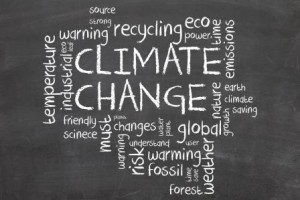November 26, 2014
 During the first two weeks of December, representatives from virtually every country in the world will gather at a United Nations convention to talk about climate change. They're developing an international agreement, slated to be signed in 2015, that will determine how we will mitigate climate change as a global community.
During the first two weeks of December, representatives from virtually every country in the world will gather at a United Nations convention to talk about climate change. They're developing an international agreement, slated to be signed in 2015, that will determine how we will mitigate climate change as a global community.
Global climate policy expert Sonja Klinsky, an assistant professor in the School of Sustainability, answers questions about climate change mitigation.
What is mitigation?
Mitigation refers to any actions taken to reduce the amount of greenhouse gases emitted into the atmosphere. Because we produce greenhouse gases in many ways, mitigation can take many different forms.
How does human activity produce greenhouse gases?
If we are going to use mitigation policies to reduce greenhouse gases in a systematic way, it is useful to identify how human actions produce greenhouse gases in the first place.
The most common greenhouse gas produced through human action is carbon dioxide, most of which is related to the use of energy. In the United States, 80% of total greenhouse gas emissions are produced through electricity production, transportation and industry. Most of these emissions are produced through the use of fossil fuels such as coal, oil and natural gas.
Some greenhouse gas emissions also come from land-use changes such as deforestation, certain agricultural practices such as raising cattle and other livestock, or land degradation. About 10% of U.S. emissions come from the agricultural sector.
What are mitigation policies? How do they reduce greenhouse gas emissions?
Mitigation policies can take many forms. For example, many cities, states and countries have worked to reduce emissions from transportation. These policies would include efforts such as:
- Developing mass public transit to reduce private automobile use,
- Designing walkable or bikable cities,
- Implementing standards for fuel efficiency, or
- Setting limits on the levels of emissions that are allowed from heavy transportation like shipping or freight transport.
Similarly, many policies have tried to reduce emissions in the electricity sector. For example, many states and countries have set standards that encourage the development of renewable energies like solar or wind power. Other policies set limits on the levels of emissions that power plants or other industrial users can emit while producing electricity. In some jurisdictions utilities are required to help consumers reduce total energy demand through actions such as:
- Increasing the efficiency of their heating or cooling systems,
- Insulating their homes, or
- Investing in energy efficient appliances.
Another common mitigation strategy is to make it more expensive to produce greenhouse gases in general. The idea is that if it doesn't cost anything to produce emissions, no-one has a reason to try to invest in efficiency improvements, innovate to develop new processes, or reduce total energy demand.
Attaching a price to the production of emissions would encourage businesses, governments and individuals to be more careful about producing them. This is called ‘carbon pricing’. Many jurisdictions use a form of carbon pricing as part of their mitigation policy. This includes states like California, Connecticut, Delaware, Maine, Maryland, Massachusetts, New Hampshire, New York, Rhode Island, and Vermont. Similarly, carbon pricing is used across the European Union, in parts of China, New Zealand, parts of Canada and in a variety of other countries.
How much mitigation is required?
The level of mitigation that we decide to do depends on how much climate change we think is acceptable. Right now the international political community has agreed to try to limit climate change to an average warming of 2°C. At this level some vulnerable communities and ecosystems would likely face serious climate impacts, but climate impacts would be less widespread and severe than if a higher degree of warming occurs.
One of the difficult things about climate change is that greenhouse gas emissions accumulate in the atmosphere, where they remain for several hundred years. We are still dealing with emissions from the industrial revolution in the atmosphere! This means that if we want to keep climate change below an average 2°C increase in the next 100 years, we may need to reduce global emissions by 40% and 70% before 2050, and to almost eliminate them entirely by 2100 (source).
Where can I get more information about greenhouse gases and mitigation?
For more information about greenhouse gas production in the United States see the U.S. Energy Information Agency’s regularly updated reports.
For a user-friendly and reliable source of information about greenhouse gas emissions globally, see the World Resources Institute’s Climate Data Explorer.
The most comprehensive analysis of climate mitigation globally is conducted by Working Group III of the Intergovernmental Panel on Climate Change. A copy of the summary report, the full report, and a video about the work of Working Group III can be freely downloaded from their website.

